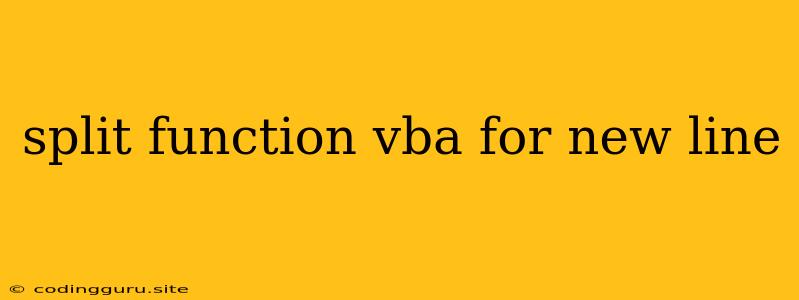Splitting Strings with New Lines in VBA
Working with text data in VBA often involves manipulating strings, and one common task is splitting a string into an array based on a specific delimiter. In this article, we'll focus on the split function in VBA and how it can be used to split strings based on new lines.
Understanding the Split Function
The Split function in VBA is a powerful tool for breaking down strings into smaller units. It takes a string as input and returns an array of substrings based on a specified delimiter. For example, to split a string by commas, you could use:
Dim strData As String
Dim arrData() As String
strData = "Apple,Banana,Orange"
arrData = Split(strData, ",")
In this example, arrData will contain an array of three elements: "Apple", "Banana", and "Orange".
Splitting by New Lines
When dealing with text that contains new line characters, you can leverage the Split function with the vbCrLf constant as the delimiter. This constant represents the carriage return and line feed combination, which is commonly used to denote new lines in Windows systems.
Dim strText As String
Dim arrLines() As String
strText = "This is the first line." & vbCrLf & "This is the second line." & vbCrLf & "This is the third line."
arrLines = Split(strText, vbCrLf)
Now, arrLines will hold an array of three strings, each representing a separate line from the original text.
Working with the Split Array
Once you've successfully split your string, you can access the individual elements of the resulting array using their indices.
Dim i As Integer
For i = 0 To UBound(arrLines)
Debug.Print arrLines(i)
Next i
This code loop will print each line from the arrLines array to the Immediate Window in the VBA editor.
Example Use Cases
Here are some common use cases for splitting strings by new lines in VBA:
- Reading data from a text file: You can read the entire contents of a text file into a string variable and then use the Split function to extract individual lines for processing.
- Parsing user input: If your application allows users to enter multi-line text, you can use the Split function to break down their input into individual lines.
- Processing log files: By splitting a log file's content by new lines, you can analyze each log entry separately.
Tips for Effective Usage
- Check for Empty Lines: If your text might contain empty lines, you can add a check to filter them out from the
arrLinesarray. - Handle Different Line Endings: While
vbCrLfis the most common line ending in Windows, other operating systems might use different combinations likevbCr(carriage return) orvbLf(line feed). You might need to adapt your code accordingly. - Combine with Other String Functions: The Split function can be used in conjunction with other string manipulation functions like
Trim,Replace, andLeftto refine your data processing.
Conclusion
The Split function in VBA, combined with the vbCrLf constant, provides a simple and efficient way to split strings by new lines. This functionality is valuable for processing text data, manipulating user input, and analyzing log files. By understanding how to utilize the Split function and its various applications, you can significantly enhance your VBA code's ability to work with text data effectively.
